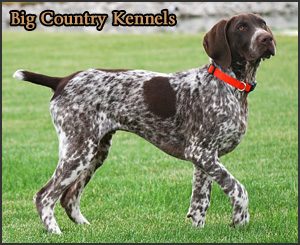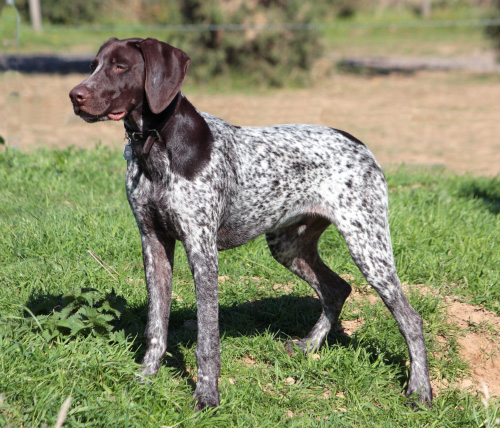
German Short-Haired Pointer
Group: Sporting Group
Origin: Germany
Height:
- – Males: 23-25 inches (58-64cm)
– Females: About 2 inches (5cm) shorter
Weight:
- – Males: 55 to 75 lbs (25-34kg)
– Females: About 10 lbs (4.5kg) less
Other Names: GSP; Deutsch Kurzhaar

CLICK HERE to View Breeder Listings
Breed Profile
The German Shorthaired Pointer is friendly, eager to please, intelligent, and has a stable temperament. He has an abundance of energy but can adapt well to family life in a suburban or country setting provided he gets lots of exercise on a daily basis. The breed is sturdy, alert, and has a great deal of endurance.
In addition to his hunting skills, the GSP excels in the conformation ring, obedience trials, agility, flyball as well as many other dog sports and activities and is also seen working as a Search and Rescue Dog.
Physically, the GSP has an appearance of nobility, being agile, well-balanced and powerful looking. As the name suggests, he has a short coat that is thick and feels tough to the touch. The hair is softer, thinner and shorter on the ears and the head. His coat may be solid liver, liver and white spotted, liver and white ticked, or liver roan. The American Kennel Club disqualifies any dog with any area of black, red, orange, lemon or tan, or solid white. The Canadian Kennel Club does not permit any colours other than liver and white(grey white). The United Kennel Club, the Kennel Club (UK) as well as the Fédération Cynologique Internationale and most other countries, however, do allow the colour black in the same range as the liver and tan markings are also permissible. (See the individual breed standards for details.)
A Brief History of the German Short-Haired Pointer
Known as the Deutsch Kurzhaar in his native Germany, the German Shorthaired Pointer was developed as an all-purpose dog in the late 1800s. The intent was to develop a versatile sporting breed that could work as a pointer, retriever, tracker and hunter of both large and small game, and to work well in all types of terrain including water. The German Shorthaired Pointer was first introduced to North America in the mid-1920s and first admitted to the American Kennel Club Stud Book in 1930. Today, the breed is both a popular sporting dog as well as a family companion.
Health Issues
If you are considering the adoption of a German Short Haired Pointer puppy, or any breed, it is very important to be selective in choosing a responsible and reputable breeder. Ensure that the prospective puppy’s parents have all health clearances. The German Shorthaired Pointer Club of America (GSPCA) strongly recommends that breeding dogs have health clearances for: Hip Dysplasia (OFA, PennHip or equivalent); Congenital Cardiac Disease (clearance by Cardiologist or Specialist); Progressive Retinal Atrophy (CERF); and Cone Degeneration Disease (DNA testing). In addition, the GSPCA suggests testing for Elbow Dysplasia as well as Autoimmune Thyroiditis (the primary cause of hypothyroidism in dogs).
Breeding of any dog should not be done until after the prospective parents have been proven to be free of evidence of significant hereditary diseases. (For more information on selecting a breeder, see the articles on the General Information page.)
Additional Health Resources:
- Health and Nutrition — Growing section of the Canada’s Guide to Dogs website which includes information on several health and nutrition related issues.
- Canine Health Information Center (CHIC) – German Shorthaired Pointer Breed Requirements — Providing a source of health information for owners, breeders, and scientists that will assist in breeding healthy dogs. CHIC is a centralized canine health database jointly sponsored by the AKC/Canine Health Foundation (AKC/CHF) and the Orthopedic Foundation for Animals (OFA).
- Canine Inherited Disorders Database – German Shorthaired Pointer
- Optigen — Cone Degeneration (CD) Test for German Shorthaired Pointers
- AKC Canine Health Foundation — Working towards developing scientific advances in canine health.
- OFA – Companion Animal Eye Registry (CAER)
- Orthopedic Foundation for Animals (OFA)
- Ontario Veterinary College (OVC)
- University of Pennsylvania Hip Improvement Program (PennHip)
- HealthGene — HealthGene Corporation is the leading provider of veterinary DNA diagnostic services in Canada.
- Labgenvet — Laboratory of Veterinary Genetics is a Canadian diagnostic laboratory that offers a comprehensive service of DNA tests for veterinary genetic diseases.

Grooming Information
- Grooming — This section of the Canada’s Guide to Dogs website includes tips, articles and information covering all aspects of dog grooming along with a listing of Groomers from across Canada.
Training Resources
- Training — For training information, see this growing section of the Canada’s Guide to Dogs website for tips, articles, as well as listings of training centres across Canada.
Additional Information
- German Shorthaired Pointers in Agility
- Clubs, Sports & Activities — For information on the many sports and activities you can get involved in with your dog.
- Working Dogs — The Working Dogs section of the Canada’s Guide to Dogs website provides information and listings of organizations that are involved in various dog jobs, such as Guide Dogs, Therapy Dogs, Police Dogs, Protection Dogs, and much more.
*NOTE 1: CHIC – The Canine Health Information Center “is a database of consolidated health screening results from multiple sources. Co-sponsored by the Orthopedic Foundation for Animals (OFA) and the American Kennel Club (AKC) Canine Health Foundation, CHIC works with parent clubs to identify health screening protocols appropriate for individual breeds. Dogs tested in accordance with the parent club established requirements, that have their results registered and made available in the public domain are issued CHIC numbers.” To learn more, visit: www.caninehealthinfo.org
*NOTE 2: The Fédération Cynologique International (FCI) is the World Canine Organization, which includes 91 members and contract partners (one member per country) that each issue their own pedigrees and train their own judges. The FCI recognizes 344 breeds, with each being the “property” of a specific country. The “owner” countries write the standards of these breeds in co-operation with the Standards and Scientific Commissions of the FCI, and the translation and updating are carried out by the FCI. The FCI is not a breed registry nor does it issue pedigrees.
Breed Listing
Quick Links
Get In Touch
- Email: canadasguidetodogs@gmail.com
- Email: info@canadasguidetodogs.com
- Visit us on Facebook: www.facebook.com/CanadasGuideToDogs
— CanadasGuideToDogs.com is an Amazon Associate as well as a participant in various affiliate programs, as such fees are earned from qualifying purchases.
